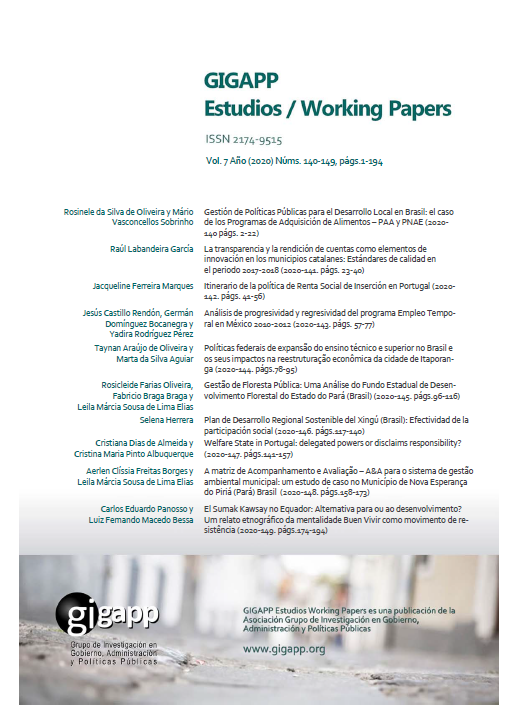Análisis de progresividad y regresividad del programa Empleo Temporal en México 2010-2012
Abstract
Both mexican economic crisis of 1994 and the US crisis of 2007 significantly affected the growth and generation of employment in Mexico. In 1995, through the implementation of the Temporary Employment Program (PET), the Mexican government tried to support the income of poorer families during periods of low labor demand or some natural disasters or economic emergency. The objective of this research is to calculate progressivity or regressivity of PET at the national level, and at subnational government level using the Stata and the microdata of the Socioeconomic Conditions Module of the National Survey of Household Income and Expenses (ENIGH) 2010 and 2012. The data indicate that in 2010, PET tended to be regressive, and resources were directed towards deciles with higher incomes, suffering a variation in 2012, which became a public program with minimal progressivity, that allocates its resources to the deciles with lower income.
Downloads
References
Centro de Información del Programa de Empleo Temporal (2015b). Geo-estadística ejercicio 2010. Recuperado el 20 de julio de 2015. Disponible en web: http://www.cipet.gob.mx/webcipet/geo-estadistica/2010/ge.cfm
Centro de Información del Programa de Empleo Temporal (2015c). Geo-estadística ejercicio 2012. Recuperado el 20 de julio de 2015. Disponible en web: http://www.cipet.gob.mx/webcipet/geo-estadistica/2012/ge.cfm
Encuesta Nacional de Ingresos y Gastos de los Hogares 2010 [Microdatos con extensión dta y descripción de la base de datos]. México, D.F., México: Instituto Nacional de Geografía y Estadística.
Encuesta Nacional de Ingresos y Gastos de los Hogares 2012 [Microdatos con extensión dta y descripción de la base de datos]. México, D.F., México: Instituto Nacional de Geografía y Estadística.
Instituto Nacional de Estadística, Geografía e Informática (2002). Guía de conceptos, uso e interpretación de la Estadística sobre la Fuerza Laboral en México. Disponible en web: http://www.inegi.org.mx/est/contenidos/espanol/metodologias/otras/guia.pdf
Instituto Nacional de Estadística, Geografía e Informática (2007).Cómo se hace la ENOE. Métodos y procedimientos. Disponible en web: http://www.inegi.org.mx/est/contenidos/espanol/metodologias/enoe/ENOE_como_se_hace_la_ENOE1.pdf
Keynes, John 1936[2003]. Teoría general de la ocupación, el interés y el dinero (4ª ed.). México: Fondo de Cultura Económica.
Marx, Carlos (1975). El Capital Tomo I, México: Fondo de Cultura Economica.
Módulo de Condiciones Socioeconómicas Encuesta Nacional de Ingresos y Gastos de los Hogares 2012 [Microdatos con extensión dta y descripción de la base de datos]. México, D.F., México: Instituto Nacional de Geografía y Estadística.
Módulo de Condiciones Socioeconómicas Encuesta Nacional de Ingresos y Gastos de los Hogares 2010 [Microdatos con extensión dta y descripción de la base de datos]. México, D.F., México: Instituto Nacional de Geografía y Estadística.
Secretaría de Desarrollo Social (2015d). Tipos y montos de apoyo, [en línea]. Recuperado el 20 de junio de 2015. Disponible en web:http://www.sedesol.gob.mx/es/SEDESOL/Montos_y_Tipos_de_Apoyos.
Secretaría de Desarrollo Social 2015a. Reglas de Operación del Programa Empleo Temporal para el ejercicio fiscal 2015. Recuperado el 20 de julio de 2015. Disponible en web: http://www.normateca.sedesol.gob.mx/work/models/NORMATECA/Normateca/Reglas_Operacion/2015/rop_pet.pdf
Secretaría de Desarrollo Social 2015b. Información del programa, [en línea]. Recuperado el 20 de junio de 2015. Disponible en web:http://www.sedesol.gob.mx/es/SEDESOL/Mas_informacion_del_Programa.
Secretaría de Desarrollo Social 2015c. Rubros de atención y proyecto tipo, [en línea]. Recuperado el 20 de junio de 2015. Disponible en web: http://www.sedesol.gob.mx/es/SEDESOL/Rubros_de_atencion_y_Proyecto_tipo.
StataCorp, Copyright 1985-2013. STATA (versión 12 y 13) [software de análisis estadístico]. Documentos en PDF de ayuda.
Copyright (c) 2020 Jesús Castillo Rendón, Dr., Germán Domínguez Bocanegra, Yadira Rodríguez Pérez (Autor/a)

This work is licensed under a Creative Commons Attribution-NonCommercial-ShareAlike 4.0 International License.
Those authors who have publications with this journal, accept the following terms:
a. Authors will retain their copyrights and guarantee the journal the right of first publication of their work, which will be simultaneously subject to the Creative Commons Attribution-NonCommercial-ShareAlike 4.0 International (CC BY-NC-SA Recognition License). 4.0) that allows third parties to share the work as long as its author and its first publication are indicated in this journal.
Under this open access license, readers (users) can:
- Share — copy and redistribute the material in any medium or format
- Adapt — remix, transform, and build upon the material
Under the following terms:
-
Attribution — Users must give appropriate credit, provide a link to the license, and indicate if changes were made. You may do so in any reasonable manner, but not in any way that suggests the licensor endorses you or your use.
-
NonCommercial — Users may not use the material for commercial purposes.
-
ShareAlike — If remix, transform, or build upon the material, users must distribute your contributions under the same license as the original.
- No additional restrictions — Users may not apply legal terms or technological measures that legally restrict others from doing anything the license permits.
b. Authors may adopt other non-exclusive license agreements for the distribution of the version of the published work (eg: deposit it in an institutional telematic archive or publish it in a monographic volume) provided that the initial publication in this journal is indicated.
c. Authors are allowed and recommended to disseminate their work through the Internet (e.g. in institutional telematic files or on their website) before and during the submission process, which can lead to interesting exchanges and increase citations of the published work. (See The effects of open access).



